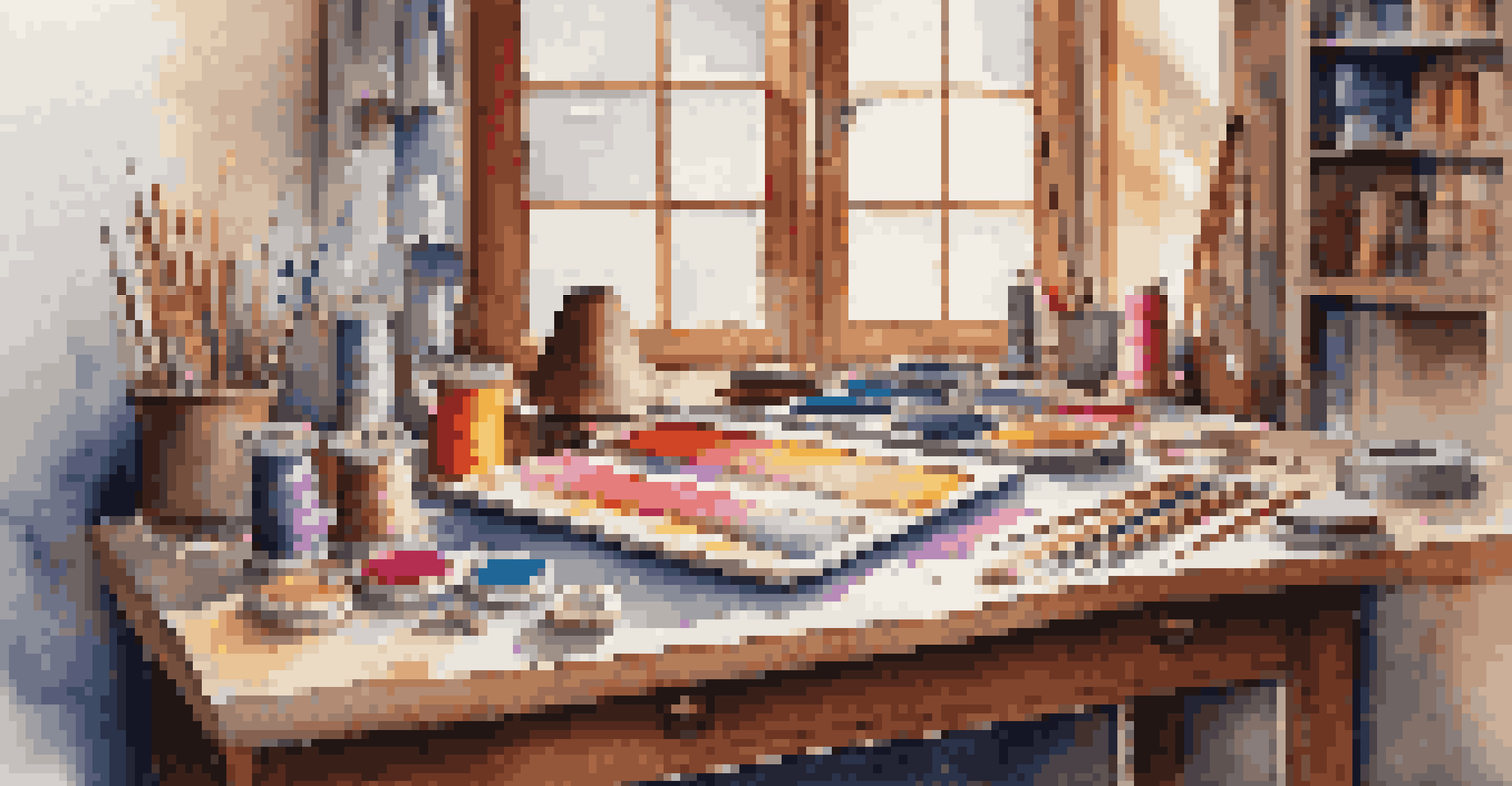Rug Making Mistakes: Common Pitfalls and How to Avoid Them

Choosing the Wrong Materials for Your Rug
One of the most frequent mistakes in rug making is selecting inappropriate materials. Each type of yarn or fabric has its own characteristics, impacting the durability and look of your rug. For instance, using wool in a high-traffic area might lead to quicker wear and tear compared to synthetic fibers.
Good design is about making other designers feel like idiots because that idea wasn’t theirs.
It's essential to consider the purpose of your rug before making a material choice. If it’s for a cozy living room, a soft wool or cotton could be perfect, whereas a bathroom rug might need something more water-resistant. Researching the properties of each material can save you time and money in the long run.
Additionally, mixing materials can lead to unpredictable results. Always test a small sample before committing to a larger project, ensuring that the texture, color, and durability meet your expectations.
Ignoring the Importance of Sizing
Another common pitfall is not properly sizing your rug for the intended space. A rug that's too small can make a room feel disjointed, while one that's too large can overwhelm the area. Measuring your space accurately is crucial before you start making your rug.

Consider how the rug will interact with your furniture. For example, in a dining room, it's generally best to have the rug extend beyond the chairs to create a cohesive look. This can enhance both the functionality and aesthetic of your space.
Choose the Right Materials
Selecting appropriate materials based on the rug's purpose ensures durability and aesthetic appeal.
Moreover, visualizing the rug in your layout can help. Use painter's tape to outline the rug's dimensions on the floor, giving you a clearer idea of how it will fit, and avoid those sizing blunders.
Neglecting Proper Techniques and Tools
Using improper techniques or tools is a surefire way to encounter problems in rug making. Whether you’re tufting, weaving, or hooking, each method requires specific tools that significantly affect the outcome. For example, using a blunt needle can lead to uneven stitches and a less polished look.
The details are not the details. They make the design.
It's also vital to follow proper techniques, as skipping steps can compromise the integrity of your rug. If you're new to rug making, consider following online tutorials or joining a workshop to learn the ropes. Practice makes perfect, and mastering these techniques will elevate your craftsmanship.
Investing in high-quality tools can make a big difference. Just like a painter needs their brushes, a rug maker needs the right equipment to create something beautiful and lasting.
Underestimating Time and Effort Required
Rug making can be a time-consuming endeavor, and underestimating the time and effort required can lead to frustration. Many beginners dive in excitedly, only to find themselves overwhelmed by the intricacies of the process. Taking the time to plan your project can make the experience much more enjoyable.
Breaking your project into smaller, manageable tasks can help. Set realistic expectations for how long each step will take, and don't hesitate to take breaks. Remember, patience is key in crafting, and rushing can lead to mistakes.
Plan Your Rug Dimensions
Properly sizing your rug in relation to your space and furniture enhances both functionality and design.
Moreover, keep in mind that the more complex the design, the more time it will require. Embrace the journey of rug making, and allow yourself to enjoy the creative process without pressure.
Skipping the Pre-Project Planning Phase
One of the biggest mistakes you can make is jumping straight into rug making without a solid plan. Pre-project planning allows you to outline your design, materials, and methods, ultimately leading to a smoother process. Without this step, you may find yourself making hasty decisions that affect the final product.
Start by sketching your design and experimenting with color palettes. This will give you a clear vision and help you visualize how everything will come together. Additionally, organizing your materials beforehand will save you time and prevent unnecessary trips to the store.
Taking the time to plan can also help you identify potential challenges before they arise. Anticipating issues allows you to adapt your approach and ensures that you stay on track.
Overlooking the Importance of Maintenance
Once your rug is completed, it’s easy to overlook maintenance, but this is crucial for longevity. Regular cleaning and care can prolong the life of your rug, ensuring that it remains a beautiful addition to your space. Dust, dirt, and stains can accumulate quickly, leading to premature wear.
Establish a routine for vacuuming and spot cleaning, and don’t forget to rotate your rug occasionally to ensure even wear. If you used natural fibers, consider professional cleaning every few years to maintain its integrity.
Embrace Feedback and Growth
Seeking feedback and learning from mistakes fosters improvement and confidence in your rug-making journey.
Furthermore, understanding the care instructions specific to your rug's materials will help you make informed decisions. Simple maintenance can make a world of difference in keeping your rug looking fresh and vibrant.
Failing to Seek Feedback and Learn from Mistakes
Many rug makers tend to shy away from sharing their work for fear of criticism, but seeking feedback can be invaluable. Constructive criticism allows you to learn and grow as a creator. Joining a community or online group can provide support and encouragement, helping you refine your skills.
Don’t be afraid to share your mistakes too. Every experienced rug maker has a story about a project that didn’t go as planned. Learning from these experiences can prevent you from making the same errors in the future.

Remember, rug making is a journey filled with learning opportunities. Embrace each mistake as a stepping stone to becoming a more skilled and confident maker.
Not Celebrating Your Achievements
Finally, one of the biggest mistakes in rug making is not taking the time to celebrate your achievements. Completing a rug is a significant accomplishment, and acknowledging your hard work is essential for motivation. Whether it’s a small project or a large masterpiece, every rug you create deserves recognition.
Consider sharing your finished work on social media or displaying it proudly in your home. Celebrate the effort, creativity, and skill that went into crafting your rug. This can inspire you to take on new projects and push your creative boundaries.
Remember, crafting is about joy and self-expression. Embrace your journey and take pride in every rug you create, as they are reflections of your unique style and dedication.